|
|
|
Sort Order |
|
|
|
Items / Page
|
|
|
|
|
|
|
| Srl | Item |
| 1 |
ID:
142540
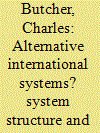

|
|
|
|
|
| Summary/Abstract |
Were precolonial state systems different to the European model? If so, how did these state systems vary, and do variations in system structure influence the frequency of war? In this article we assess the structure off international systems in nineteenth-century West Africa, Southeast Asia, and South Asia using new data on precolonial states that corrects for some of the biases in the existing Correlates of War state system membership data. We develop a framework to capture variation in political order above and below the state, and explore the similarities and differences between these systems and the European system we know and study. We then assess how rates of inter- and intra-state war varied across these systems. Our results suggest: (1) It is the nature of hierarchy (not so much anarchy) that varies across these systems; and (2) inter-state wars are more frequent, but less intense, in systems composed of decentralised states.
|
|
|
|
|
|
|
|
|
|
|
|
|
|
|
|
| 2 |
ID:
186813


|
|
|
|
|
| Summary/Abstract |
Do more protesters on the streets make governments likely to grant their demands? Several studies link protest size and government concessions. Yet existing research has limitations: many studies suffer from potential endogeneity due to potential protesters joining protests when they anticipate that concessions are likely, causal mechanisms are often unclear, and many of the most rigorous event-level studies are limited to Western democracies. We reexamine this relationship in a non-Western sample using a novel instrumental variable approach, using Fridays as an instrument for exogenous variation in protest size in predominately Muslim countries. We perform two analyses: one using the NAVCO 3.0 dataset, and the second using the Mass Mobilization in Autocracies Dataset (MMAD). In both analyses exogenous variation in protest size negatively affects the likelihood of concessions. Larger protests are less likely to receive government concessions. We suggest these surprising results point to the importance of unanticipated protests that produce new information about regime stability to motivate government concessions.
|
|
|
|
|
|
|
|
|
|
|
|
|
|
|
|
| 3 |
ID:
154067
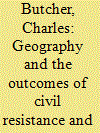

|
|
|
|
|
| Summary/Abstract |
This paper reports the results of the first cross-national examination of the impact of the geography of nonviolent contention on regime transitions. Nonviolent tactics ‘work’ in part by signalling the preferences of non-participants through the symbolism of participants, unlike violent tactics. This opens the way for nonviolent campaigns to exploit variations in social-spatial meaning to enhance the informativeness of dissent. Capital cities are one such symbolic place and the main prediction of this study is a positive relationship between large protests and regime transitions in the capital, but not elsewhere. I also predict a strong direct relationship between the proximity to the capital of fighting in civil wars, and regime transitions; no relationship to the proximity of nonviolent contention; and that the intensity of violent conflict impacts regime transitions in a way that is largely independent of location. Results from an analysis of episodes of violent and nonviolent conflict from 1990 to 2014 generally support these contentions.
|
|
|
|
|
|
|
|
|
|
|
|
|
|
|
|
| 4 |
ID:
185195
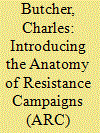

|
|
|
|
|
| Summary/Abstract |
We introduce the Anatomy of Resistance Campaigns (ARC) dataset, which records information on 1,426 organizations that participated in events of maximalist violent and nonviolent contention in Africa from 1990 to 2015. The ARC dataset contains 17 variables covering organization-level features such as type, age, leadership, goals, and interorganizational alliances. These data facilitate new measurements of key concepts in the study of contentious politics, such as the social and ideological diversity of resistance episodes, in addition to measures of network centralization and fragmentation. The ARC dataset helps resolve existing debates in the field and opens new avenues of inquiry.
|
|
|
|
|
|
|
|
|
|
|
|
|
|
|
|
| 5 |
ID:
173141
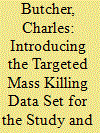

|
|
|
|
|
| Summary/Abstract |
This article describes a new data set for the study of genocide, politicide, and similar atrocities. Existing data sets have facilitated advances in understanding and policy-relevant applications such as forecasting but have been criticized for insufficient transparency, replicability, and for omitting failed or prevented attempts at genocide/politicide. More general data sets of mass civilian killing do not typically enable users to isolate situations in which specific groups are deliberately targeted. The Targeted Mass Killing (TMK) data set identifies 201 TMK episodes, 1946 to 2017, with annualized information on perpetrator intent, severity, targeted groups, and new ordinal and binary indicators of genocide/politicide that can serve as alternatives to existing measures. Users are also able to construct their own indicators based on their research questions or preferred definitions. The article discusses the concept and operationalization of TMK, provides comparisons with other data sets, and highlights some of the strengths and new capabilities of the TMK data.
|
|
|
|
|
|
|
|
|
|
|
|
|
|
|
|
| 6 |
ID:
143347
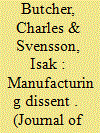

|
|
|
|
|
| Summary/Abstract |
A growing research field examines the conditions under which major nonviolent resistance campaigns—that is, popular nonviolent uprisings for regime or territorial change—are successful. Why these campaigns emerge in the first place is less well understood. We argue that extensive social networks that are economically interdependent with the state make strategic nonviolence more feasible. These networks are larger and more powerful in states whose economies rely upon organized labor. Global quantitative analysis of the onset of violent and nonviolent campaigns from 1960 to 2006 (NAVCO), and major protest events in Africa from 1990 to 2009 (SCAD) shows that the likelihood of nonviolent conflict onset increases with the proportion of manufacturing to gross domestic product. This study points to a link between modernization and social conflict, a link that has been often hypothesized, but, hitherto, unsupported by empirical studies.
|
|
|
|
|
|
|
|
|
|
|
|
|
|
|
|
| 7 |
ID:
154956


|
|
|
|
|
| Summary/Abstract |
It is time to integrate quantitative atrocity forecasting more directly and systematically into the foreign policy processes of middle and major powers interested in preventing these terrible but all too common events. Sascha Nanlohy, Charles Butcher and Benjamin E Goldsmith discuss the potential utility of relatively reliable mid-to-long-term forecasts, using a number of examples to illustrate the main points.
|
|
|
|
|
|
|
|
|
|
|
|
|
|
|
|
| 8 |
ID:
160477
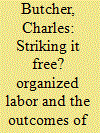

|
|
|
|
|
| Summary/Abstract |
This study draws from organizational theory to explain the outcomes of civil resistance campaigns. Organizational theory suggests that organizations embedded in extensive interpersonal networks upon which the state partially depends bring “leverage” to civil resistance campaigns and increase the likelihood of major government concessions in the short term. Also, organizations with strong local ties and a confederal “national” structure should bring resilience and reduce the probability of short term failure. We argue that, in general, National Trade Unions (NTUs) approximate these organizational features. Using new data on the participation of NTUs in civil resistance campaigns, our results suggest that NTU participation increases the likelihood of short-term success and decreases the chances of short-term failure. NTU participation also improves the prospects of postconflict democratization. In contrast, campaign size is robustly associated with short-term success but not with the probability of failure or postconflict democratization. Our research suggests that an “organizational” turn is a productive step toward understanding the short- and long-term outcomes of nonviolent campaigns.
|
|
|
|
|
|
|
|
|
|
|
|
|
|
|
|
|
|
|
|
|